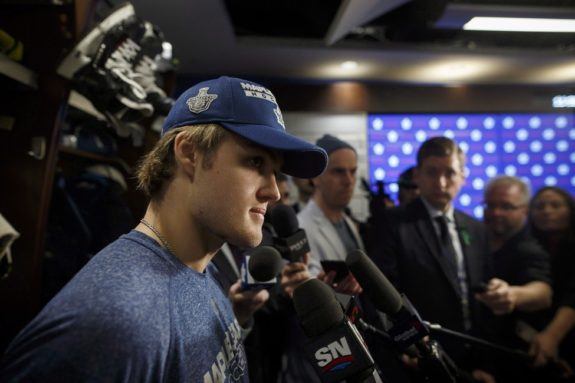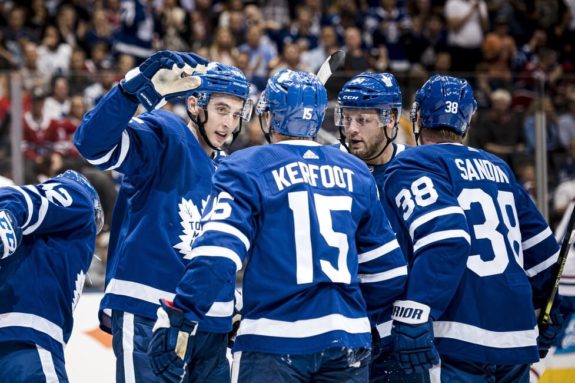In recent days we have looked at two aspects of the ongoing negotiations between the Toronto Maple Leafs’ General Manager Kyle Dubas, Rasmus Sandin, and his agent Lewis Gross.
In our first post, we stated we didn’t think there was any reason to panic yet. In our second we questioned whether or not a decision Dubas made three seasons ago might be coming back to haunt him now.
Related: Maple Leafs’ Rasmus Sandin Has Little Choice But to Become a Star
Today we ask the questions, is Rasmus Sandin making a good choice in prolonging the negotiations, and is he getting good advice from his agent Gross (or elsewhere)?
A Protracted Holdout Can Carry a History of Bad Feelings
We still think the odds are that both sides come to an agreement before training camp opens and this gets put in the past for most of us. But, with how closely the media follows the Maple Leafs along with social media adding to the publicity, we can see where some fans will take a negative approach to Sandin. All we have to do is look at the flak that William Nylander and Mitch Marner get over the negotiations for their last contracts.

If this deal does not get done by training camp there is also the potential damage it could do to Sandin’s reputation within the NHL itself. General Managers don’t take kindly to players rocking the boat, especially younger players who have yet to solidify a full-time roster spot.
Can Negotiations Impact On-Ice Performance?
Players have ended up with bad reputations amongst NHL teams for a number of reasons. The main ones seem to be perceived selfishness and a player putting himself before the team. Some players who come to mind that have been placed in that category by some are PK Subban, Alex Galchenyuk, and Josh HoSang.
Related: Flyers Lookback: The Shea Weber Offer Sheet
Then there are players who seem to overvalue themselves when it comes to their contracts. One player we can think of was former Maple Leafs’ player Cody Franson. Franson was a right-shot defenseman who had size (6-foot-5, 225-pounds) and some talent. Over his last three seasons with the Maple Leafs (from 2012-2015), he averaged 30 points a season. He always had sound analytics as well.
But, whenever it came time to sign a new deal it always seemed to drag on forever before an agreement was arrived at.
Franson never seemed to reach the level of play that his talent level seemed to indicate he should. We can’t help but wonder if the issues he had come to contract time had anything to do with that. (Franson, who’s now 35 years old, played last season with the Hershey Bears.)
The NHL Pay Structure Is Logical and Mostly Works for Players
The pay structure of the NHL and how it affects younger unproven players such as Sandin works for a reason. It was negotiated by the league and the player’s union to benefit both sides.
Step one, a player is drafted and becomes the sole property (as a professional hockey player) of that NHL team for a given length of time.

Step Two, the player signs his entry-level contract. At first, he has no bargaining rights and is limited in how much money he can make by the league CBA contract. He can be moved up and down between the NHL and the minor leagues freely.
Step Three, after a given length of time the player can no longer be moved back and forth between the NHL and the minor leagues without clearing waivers.
Step Four, the player gains arbitration rights, which helps his ability to negotiate for more money.
Step Five, the player can become an unrestricted free agent and can sign with and play for the highest bidder.
Where Sandin Is on That Ladder
Sandin is just entering step three. For the first time in his career, he can no longer be sent to the minors without clearing waivers. He still has yet to reach step four where he qualifies for arbitration.
Related: Nylander Contract Dispute Nearing the End
For the most part, a player in Sandin’s position seems wise to take what he can get, which in this case seems to be about the same offer his teammate Timothy Liljegren just accepted. That contract would be around two years at $1.4 million per season. When his next contract is due, as long as his game keeps progressing, Sandin would then have arbitration rights to help him get more money.
Might Sandin’s Strategy Backfire in the Longterm?
It appears unless it’s his own idea, the advice he’s getting from other sources (given history, one would think it could be his agent) that Sandin is unwilling to accept what the team is offering.

Of course, we have no way of knowing what’s motivating Sandin or what his thinking is. It’s possible however that, if he decides to play hardball and extend these negotiations beyond training camp, he risks alienating Maple Leafs’ fans. He also risks gaining a negative reputation with the people he will be depending on to hire him and pay him in the future.
These negotiations are not the end of the world obviously. However, Toronto is a tough market to play in. And there’s history to suggest that the reputation of both William Nylander and Mitch Marner has suffered since their own renegotiations.
Related: Maple Leafs’ Sandin Has Higher Potential Than Rielly
We’ve been huge supporters of Sandin’s skills in our writing over the past two years. We’d hate to see him in a pickle in a city where he could one day become a beloved star.
The problem is that he’s not there yet.
[Note: I want to thank long-time Maple Leafs’ fan Stan Smith for collaborating with me on this post. Stan’s Facebook profile can be found here.]